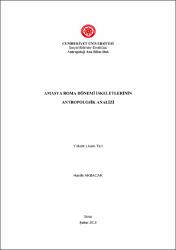| dc.contributor.advisor | Kırmızıoğlu, Pınar Gözlük | |
| dc.contributor.author | Akbacak, Hanife | |
| dc.date.accessioned | 2022-04-28T08:56:13Z | |
| dc.date.available | 2022-04-28T08:56:13Z | |
| dc.date.issued | 2018 | tr |
| dc.date.submitted | 2018-02-06 | |
| dc.identifier.other | XI, 89 sayfa | |
| dc.identifier.uri | https://hdl.handle.net/20.500.12418/12506 | |
| dc.description.abstract | Amasya’da ilk yerleşimlerin MÖ 5500 - 3000 yıl öncesine kadar dayandığı bilinmektedir. Roma dönemine kadar birçok medeniyete ev sahipliği yapan Amasya, yaklaşık 500 yıl kadar da Romalıların egemenliği altında varlığını sürdürmüştür .
Bu tezin konusu, Amasya İli ve çevresinde, Roma dönemine tarihlendirilen çeşitli arkeolojik alanlarda yapılan kazılar sonucu ele geçirilen insan iskeletlerinin, antropolojik açıdan değerlendirilmesidir. Bu topluluğu oluşturan bireylerin paleodemografik ve morfolojik yapılarının ortaya konulması, bireylerdeki paleopatolojik oluşumların saptanması, elde edilen verilerin diğer eski Anadolu toplumları ile karşılaştırılması, aralarındaki benzerlik ve farklılıkların bulunması bu tezin amacını oluşturmaktadır.
Topluluğun paleodemografik dağılımına baktığımızda, toplam 56 bireyin 2’si (% 3,57) bebek, 11’i (% 19,64) çocuk, 15’i (% 26,79) kadın, 13’ü (%23,21) erkek ve 15’i de (% 26,79) yaşı ve cinsiyeti bilinmeyen bireylerden oluştuğu saptanmıştır. Erişkin bireylerin yaş ortalaması 39,4 yıl, kadınların 40,3 erkeklerin 38,8 yıldır. Toplumun erişkin bireylerinin yaşam uzunlukları diğer Roma dönemi toplumlarıyla benzer değerler göstermiştir.
Bireylere ait toplam 196 diş incelenmiştir. Bunların 24’ü süt dişlerden 172 tanesi daimi dişlerden oluşmaktadır. Diş ve çene paleopatolojilerine bakıldığında aşınma süt dişlerde +2 dereceye kadar, daimi dişlerde ise üst çenede 3. derece, alt çenede ise 4ve 5 derecedir. Daimi dişlerde çürük oranı % 4,65, hypoplasia % 4,65, diş taşı % 2,91, apse % 1,35, antemortem diş kaybı % 6, 28, oranında görülmektedir. | tr |
| dc.description.abstract | It is known that the first settlements in Amasya province date back BC 5500- 3000. Amasya, which hosted many civilizations by Rome Period, has continued their existence under domination of Romans about 500 years.
The subject of this thesis is the anthropological evaluation of the human skeletons that were excavated in various archaeological sites dated to the Roman period in Amasya provience and its surroundings. The goal of this thesis is to compose paleodemographic and morphological analysis and determinig of paleopathological lesions of individuals in population. In addition, it is compared findings and to obtain similarity and diversity with ancient Anatolian communities.
When we look at the paleodemographic distribution of the community, (3.57%) 2 of the 56 individuals were infants, 11 (19.64%) were children, 15 (26.79%) were women, 13 (23.21%) were men and 15 (26.79%) of individuals were found to be composed of unknown by age and sex. Average age is 39,4 years in adults, 40,3 years in women, 38,8 in men. The life span of the adult individuals of society were similar to those of other Roman-era societies.
A total of 196 teeth belonging to individuals were examined. Of these, 24 consist of deciduous teeth and 172 of them consist of permanent teeth. Dental attrition is +2 degree in deciduos and 3 degree at upper jaw, 4-5 degree at lower jaw in permanent teeth, when the dental and jaw paleopathologies are examined. Dental caries is 4,65 %; dental enamel hypoplasia is 4,65 %; dental calculus is 2,91 %; abscess is 1,35 %; antemortem tooth loss is 6,28 % in permanent teeth. | tr |
| dc.language.iso | tur | tr |
| dc.publisher | Sivas Cumhuriyet Üniversitesi - Sosyal Bilimler Enstitüsü | tr |
| dc.rights | info:eu-repo/semantics/openAccess | tr |
| dc.subject | Amasya | tr |
| dc.subject | Roma Dönemi | tr |
| dc.subject | Paleodemografi | tr |
| dc.subject | Paleopatoloji | tr |
| dc.title | Amasya Roma Dönemi İskeletlerinin Antropolojik Analizi | tr |
| dc.type | masterThesis | tr |
| dc.contributor.department | Sosyal Bilimler Enstitüsü | tr |
| dc.relation.publicationcategory | Tez | tr |















